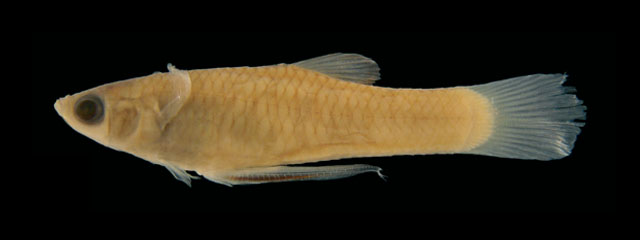|
Phalloceros aspilos Lucinda, 2008 |

|
|
photo by
Lucinda, P.H.F. |
| Family: | Poeciliidae (Poeciliids), subfamily: Poeciliinae | |||
| Max. size: | 2.38 cm SL (male/unsexed); 3.83 cm SL (female) | |||
| Environment: | pelagic; freshwater | |||
| Distribution: | South America: Brazil: Rio Parati-Mirim, Rio de Janeiro (Ref. 76852). | |||
| Diagnosis: | Dorsal soft rays (total): 7-8; Anal soft rays: 9-11; Vertebrae: 33-33. Diagnosed by the following uniquely derived autapomorphy: hypural plate almost bipartite, with very large aperture. P. aspilos is readily distinguished from its congeners, except P. tupinamba and P. leptokeras by the presence of a lateral ramus of the female urogenital papilla; female urogenital papilla left turned; large sickle like hook on the gonopodial appendix located in its inner surface and close to its base; and absence of inconspicuous vertical bars along body sides. Phalloceros aspilos can be distinguished from P. leptokeras and P. tupinamba by the absence of lateral spot. Phalloceros aspilos can also be distinguished from P. tupinamba by the predorsal length of males (54.8-56.3 vs. 57.5-59.7 % SL, respectively) (Ref. 76852). Description: Pectoral fin with 6-7 branched rays; longitudinal series of scales 28-30; transverse series of scales 7 (Ref. 76852). | |||
| Biology: | ||||
| IUCN Red List Status: | Least Concern (LC); Date assessed: 07 November 2018 Ref. (130435) | |||
| Threat to humans: | harmless | |||